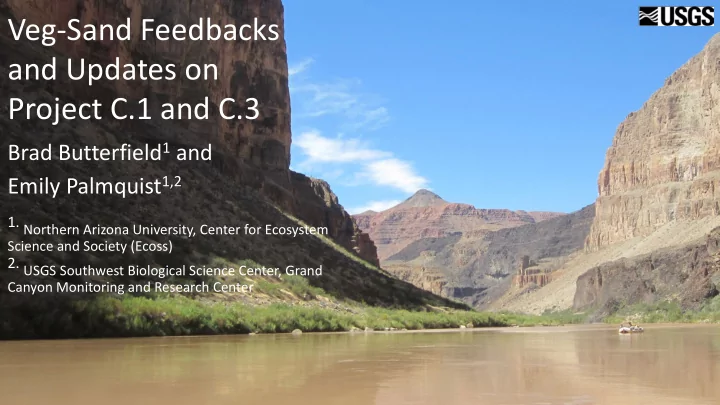

Veg-Sand Feedbacks and Updates on Project C.1 and C.3 Brad Butterfield 1 and Emily Palmquist 1,2 1. Northern Arizona University, Center for Ecosystem Science and Society (Ecoss) 2. USGS Southwest Biological Science Center, Grand Canyon Monitoring and Research Center
Project Elements and Objectives • C.1 Ground-based vegetation monitoring • Objective: Monitor annual changes to riparian species composition and cover • C.3 Vegetation responses to LTEMP flow scenarios • Objective: Develop predictive models of vegetation composition as it relates to hydrological regime • Riparian Vegetation Resource Objectives: • “Maintain native vegetation and wildlife habitat, in various stages of maturity, such that they are diverse, healthy, productive, self-sustaining, and ecologically appropriate.”
How is Vegetation Impacting Sediment?
Morphological Guilds: Diehl et al. 2017 Bioscience Diehl et al. 2017 Bioscience
Hydrological Zones Butterfield et al., In press, River Research and Applications
Geomorphic Position Separation Zone Central Zone Reattachment Zone Butterfield et al., In press River Research and Applications
Plant morphological Plant guild + guild elevation change Elevation Change (m) 2013-2018 Butterfield et al., In press, River Research and Applications
Vegetation Effects - Expectations • Expected patterns • Increase in deposition (positive change) with increasing guild number (larger, more rigid) • Consistent interaction with geomorphic position Butterfield et al., In press, River Research and Applications
Butterfield et al., In press, River Research and Applications Vegetation Effects - Observed
Vegetation Effects • Species effects depended on geomorphic position • Low-statured, rhizomatous species captured sediment best in high- velocity areas (separation zone) • Large shrubs captured sediment in low-velocity areas (reattachment zone) • Identifies specific sediment impacts based on guild, hydrological zone, and geomorphic position that can be used to achieve sediment management targets Butterfield et al., In press, River Research and Applications
Project Element C.1. Ground-Based Inactive Vegetation Floodplain Monitoring • >20,000 Plots surveyed Active Floodplain since 2014 • River-system-wide • NAU sandbars • 5-year Status and Trends Active forthcoming Channel • In case you missed yesterday’s poster… Preliminary data, do not cite
Project Element C.3. Vegetation Responses to LTEMP Flow Scenarios 1991 at 51 Mile • Developed environmental niche models for common species • First used to assess vegetation optima relative to current flow regimes • Beginning to use these models to project habitat suitability in the future under different flow scenarios (Kasprak et al. In prep) Butterfield et al. 2018 AVS
NATIVE RIPARIAN SHRUBS (e.g., baccharis, willow, mesquite) NON-NATIVE RIPARIAN SHRUBS (e.g., tamarisk) RIPARIAN HERBS (e.g., phragmites, Bermuda grass) XERIC SHRUBS/GRASSES In many locations, Vegetation is likely to colonize most of the remaining bare sand area (e.g., brittlebush, creosote, Kasprak et al. In prep Preliminary data, do not cite annual/perennial grasses)
Approaches to Predicting Flow Responses Long-Term Monitoring Manipulative Experiments (Ground-Based & Outside The Canyon Remotely-Sensed) Bayesian Modeling Bayesian Modeling Other River Systems & Flow Physiological Regimes Measurements Inside The (“Grand Canyon in Context”) Canyon
Manipulative Experiments Outside The Canyon
Manipulative Experiments Outside The Canyon, cont. Before After
• Harnessing “big data” by merging extensive datasets “Grand Canyon in Context” • Georeferenced herbarium records • National Hydrography Database • Climate data • Monitoring data from other • Is Grand Canyon hot and dry for this relevant river species? Or cold and wet? How does systems that affect flow response? • NCPN • Big Rivers • What flow regimes represent suitable conditions for species in Grand Canyon? Preliminary data, do not cite Butterfield, Palmquist and Hultine In prep
Physiological Measurements Inside The Canyon • Water isotopes: Which species are using river water, and to what degree? • Different deuterium signatures in river water versus precipitation-derived moisture • Can vary with season (Smith et al. 1998 Wetlands ) • Transpiration and photosynthesis • Seasonal timing of activity • Responses to changes in flow • Seasonal • Diurnal • HFEs Butterfield et al., In press, River Research and Applications
Approaches to Predicting Flow Responses, cont. Long-Term Monitoring Manipulative Experiments (Ground-Based & Outside The Canyon Remotely-Sensed) Bayesian Modeling Bayesian Modeling Other River Systems Physiological (“Grand Canyon in Measurements Inside The Context”) Canyon
Recommend
More recommend